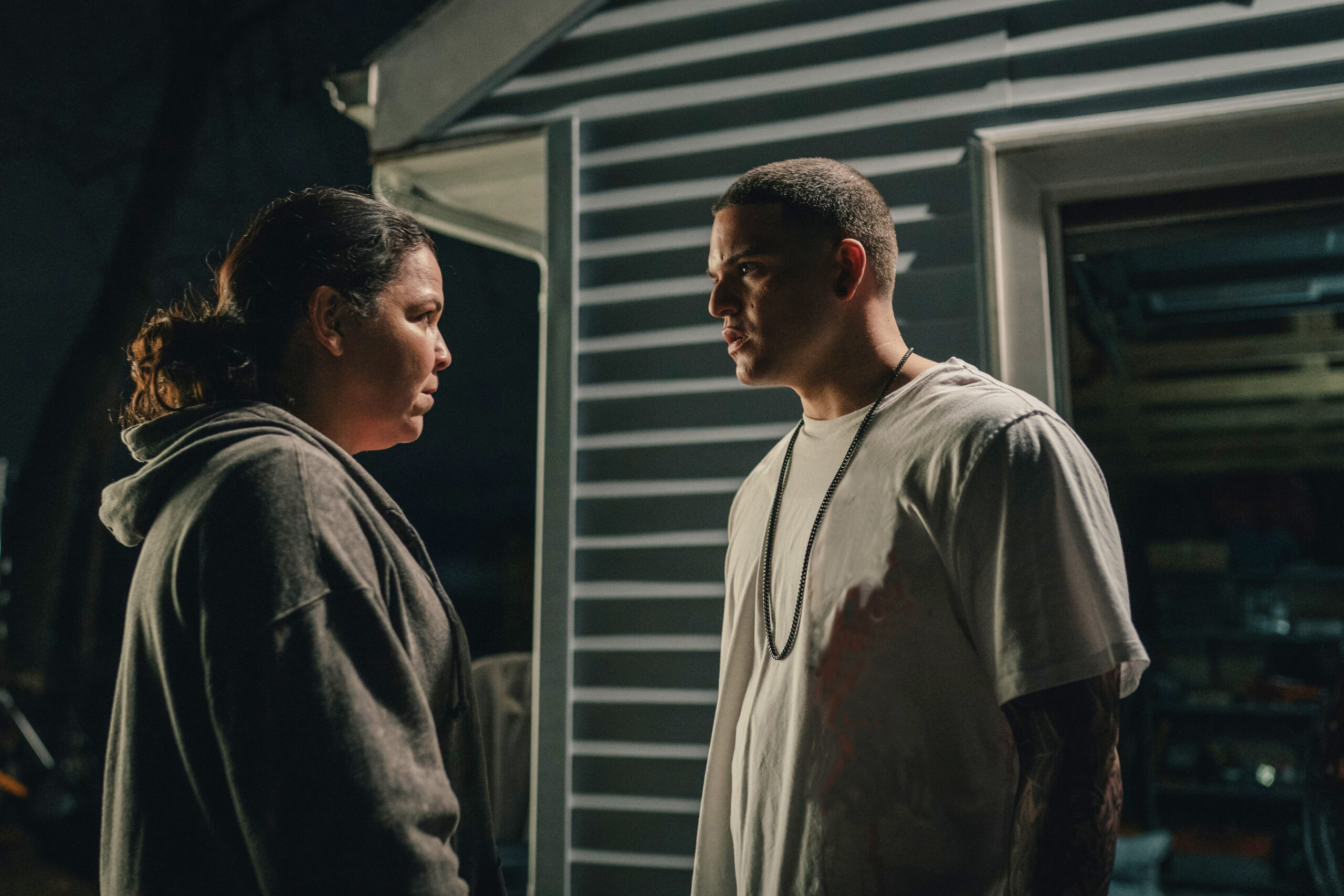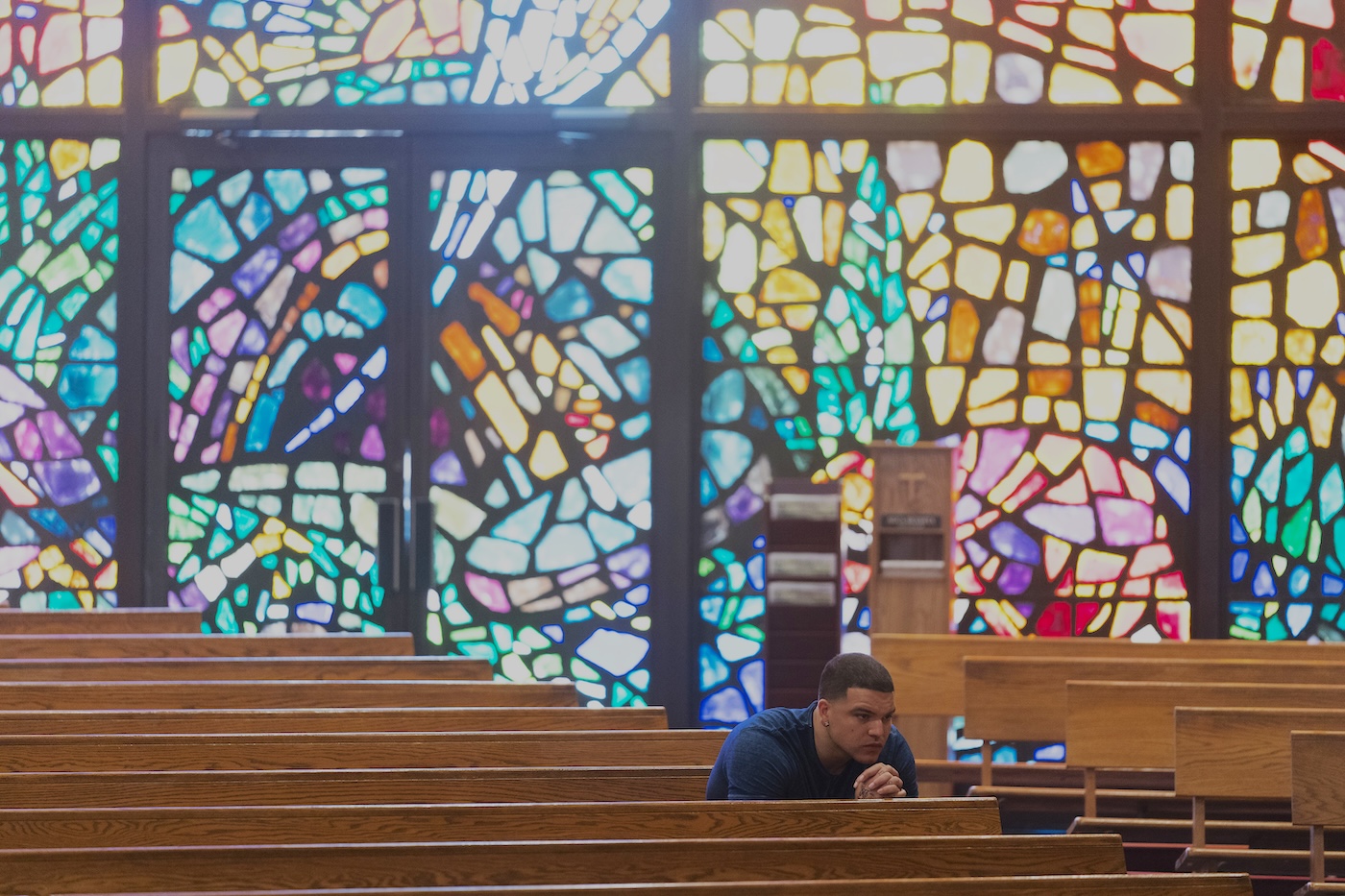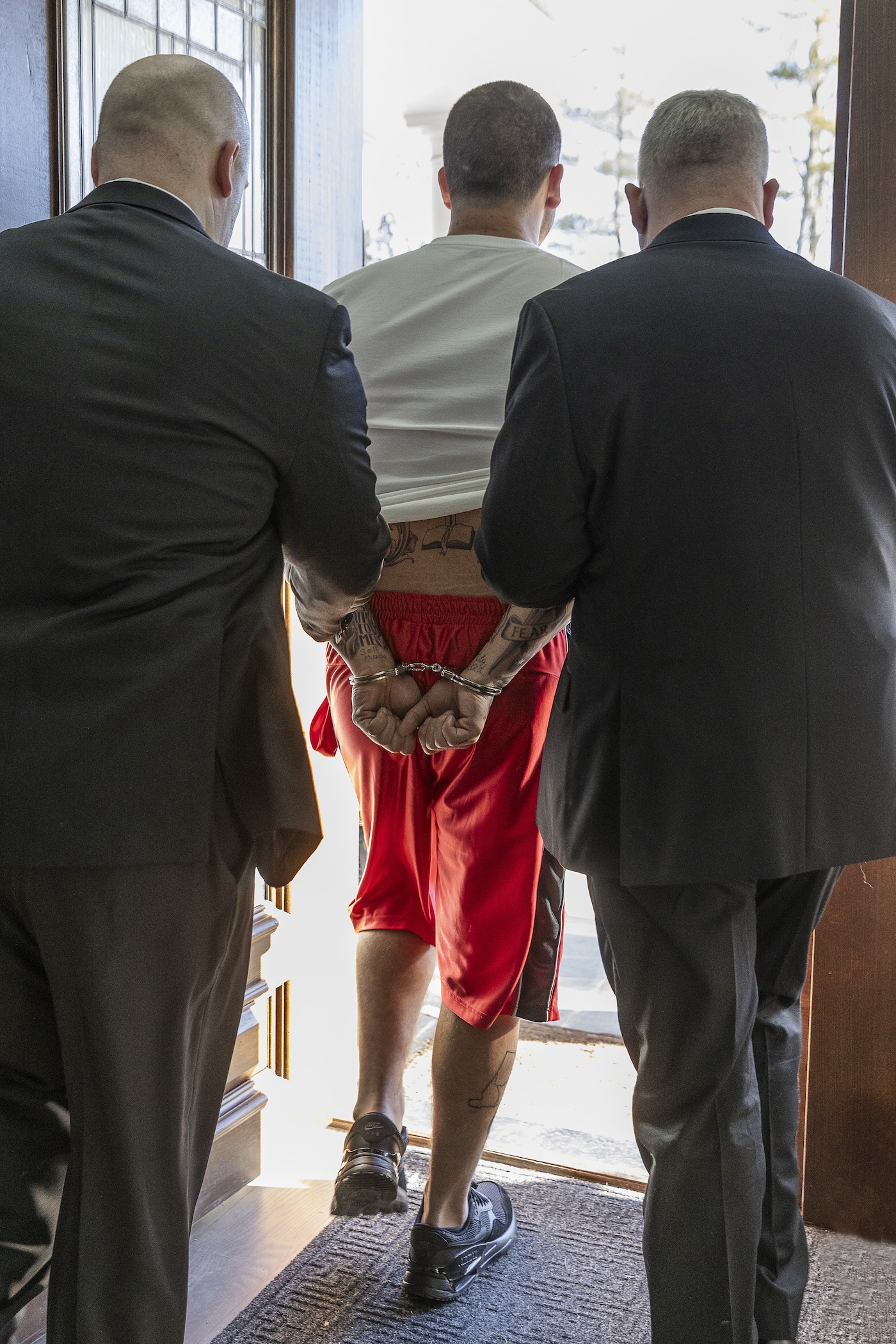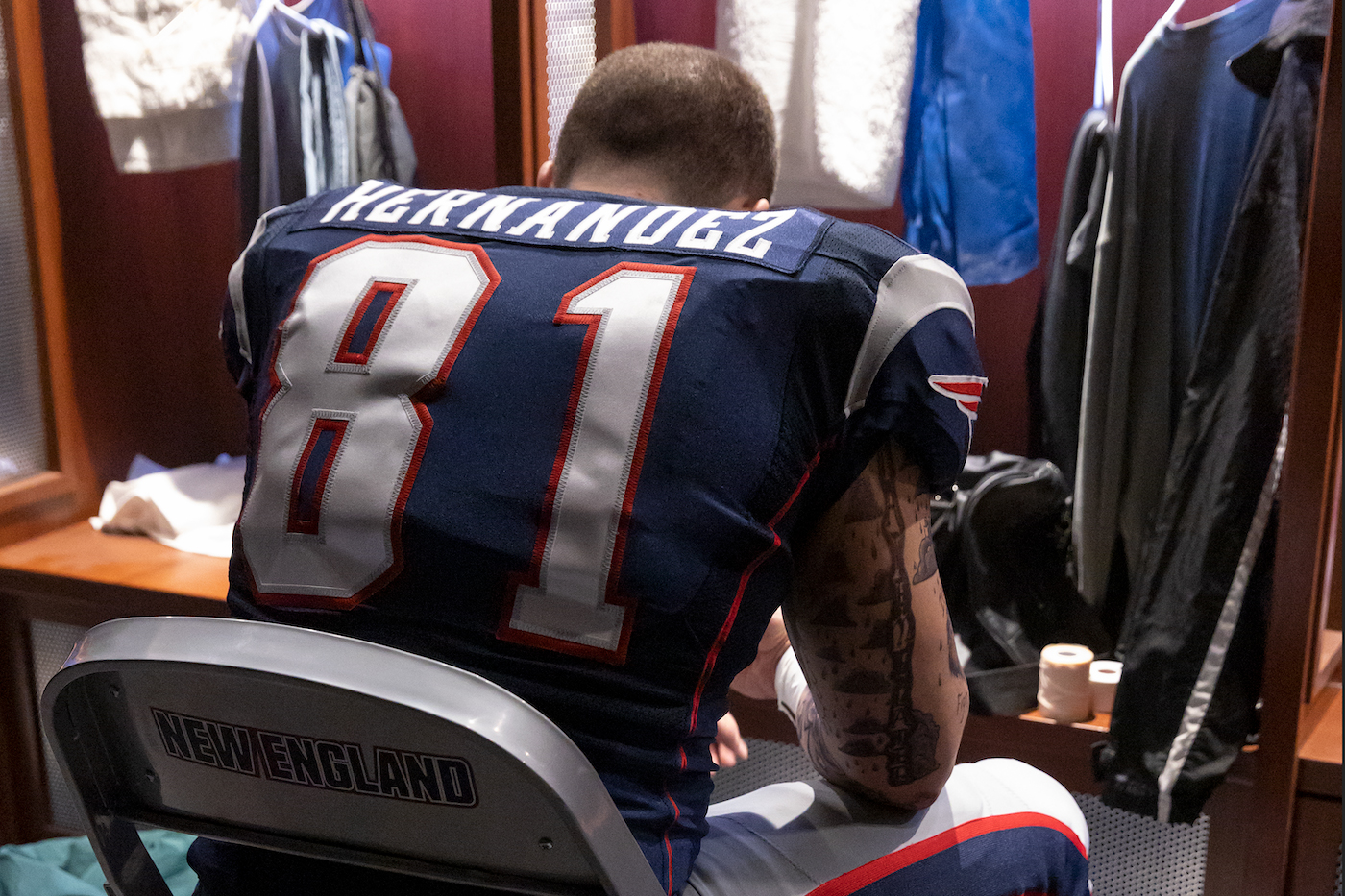FX’s newest anthology series is a tough, compelling watch that says as much about the ruthless industrialization of American sports as it does its troubled protagonist.
by Margot Lester / Photos by Eric Liebowitz & Michael Parmelee / FX
In 2013, NFL star tight-end Aaron Hernandez murdered Odin Lloyd. The crime rocked the league, the New England Patriots, and their fans. But that’s only part of the story. The event catalyzed a review of Hernandez’s life – how what he endured repeatedly on the field and in the massive collegiate-professional football complex that boxed him in influenced his choices and ultimately impaired his cognitive function and emotional regulation.
FX’s American Sports Story: Aaron Hernandez, based on the podcast Gladiator: Aaron Hernandez and Football Inc. from The Boston Globe and Wondery, is the latest in Ryan Murphy’s American Story franchise, which includes American Horror Story and American Crime Story. Executive producers from past Murphy shows included Nina Jacobson, Brad Simpson, Alexis Martin Woodall, Eric Kovtun, Scott Robertson, with the show’s creator, Stuart Zicherman, and director Carl Franklin coming on as new EPs. The 10-episode limited series is equal parts sports biopic and true-crime tale. Still, the similarities to anything similar end there: Hernandez had CTE (chronic traumatic encephalopathy), a degenerative and progressive disease in people who have received repeated concussions and traumatic brain injuries. According to Ann McKee, an expert at Boston University’s CTE Center, the NFL star had the most severe case ever seen in a person his age (27), which gravely impacted his cognition, judgment, and decision-making.
Director of Photography duties were shared equally for the ten episodes, with Elie Smolkin, CSC, lensing Episodes 1, 2, 5, 6, and 9 and Greta Zozula shooting 3, 4, 7, 8, and 10. As Zozula describes: “Aaron’s story is very complicated, and there was a lot of care and time taken to examine his whole life and the events leading up to the murder.” Director Maggie Kiley, a veteran of several true-crime projects (Dr. Death, Dirty John) who was joined on the series by directors Paris Barclay, Steven Canals, Jennifer Lynch, Michael Uppendahl, and Franklin, adds that “it was important for the show to find balance – to be respectful and not salacious, to take time with every actor who is embodying either perpetrator or victim. The weight of the work on these kinds of shows is something we all have to carry with thoughtfulness and attention.”

The pilot episode serves up a football story, charting the rise of a standout tight end from his humble origins to high school accolades, collegiate fame, and NFL stardom. Any Given Sunday, the HBO series Hard Knocks, and game film of Hernandez in action were reference points for the directors of photography. Although the N.Y.C.-based Zozula had filmed sports and some high school football scenes for a previous project, big-time college and NFL ball was new territory. “I had to do a lot of research to catch up with the sport, including the NFL draft and the scouting combine,” Zozula recounts. “Game Changing Films, our football coordinating team, were incredible, and I learned a lot very quickly from them and gained a lot of respect for the sport.”
The Game Changing team (comprising a SAG member, an ex-pro, and college players) recreated Hernandez’s most iconic plays, including the ankle injury that precipitated his substance abuse and the on-field collision that rattled his brain. They ran actual practices with the actors, stunt players, and operators to map out the shots. Cameras were positioned as they would be for a TV broadcast, on the sidelines NFL Films-style, and on the field in the middle of the action. Other cameras went long-lensed for super-tight moments and details through the crowd.
“Josh Rivera, who plays Aaron, was incredibly present with us as operators so we could always be in sync with him. That relationship between the actors and operators is vital,” notes A-Camera/Steadicam Operator Kyle Wullschleger, who operated Episodes 1-5, with Ryan Toussieng, SOC, coming in as A-Camera/Steadicam Operator for Episodes 6-10. “We shot in lots of conditions – from freezing rain to hot summer days – but the way it looks and cuts together made it all worth it. We would always have a huge list of shots, and different camera configurations to get through, so it made it exciting to move from doing Steadicam into Aaron’s POV with a facemask mounted in front of the lens to watching or working next to the Ronin on an RC car rig… we had some great tools at our disposal and were able to make some phenomenal sequences.”
The Ronin got into spots the Steadicam could not, bringing the audience to the players’ level. As Director Kiley recalls: “There’s a montage in episode five of NFL games where, in addition to multiple more objective frames on the game action, we ran a play on the Ronin with B-Cam Operator Chris Aran behind Aaron or his double. It was incredible what that shift in perspective did – suddenly, you’re immersed in the game and running with speed and a barrage of players and information coming at you. It was so important that the audience had the opportunity to run a play with Aaron to experience his athletic skill and agility. His roaring appetite to win was completely palpable when we ran these plays off the Ronin.”

First AC Randy Maldonado was tasked with figuring out “how to pull focus on Steadicam shots that would see the entirety of the football field – literally 360 degrees,” he laughs now. “I created a focus belt, which allowed me to follow the Steadicam even in the middle of the scrimmage line, while not being seen and still having a solid image. It allowed me to become one with Kyle and Ryan so they didn’t have to run across the field wearing the Steadicam too many times, as the camera package was about 70 pounds.”
Production Designer Henry Dunn appreciates the care the DPs took not to lose the emotion of the action. “Both of them ended up shooting the football sequences not just for their athletic prowess, but also for their inner pain and beauty, and the toll it took on Aaron,” Dunn describes. “I’m not aware of other shows that tried that, but both of the DP’s were committed to that idea.”
Smolkin collaborated with the producers, Dunn and Costume Designer Melissa Vargas to establish the color arc and the visual representation of Aaron’s CTE. “Stu Zicherman wanted us to help create that feeling visually,” Smolkin shares. “We’re slowly building to a point where Aaron’s memory is fragmented, he gets headaches and sensitivity to light, he’s paranoid and on edge. The visual language was designed to feel like you are experiencing it all with him.” The Guild camera team used a Sony VENICE 2 rated at 2500 ISO (a few setups required the smaller RED KOMODO). As Smolkin adds: “We chose the VENICE 2 because it was beneficial to have the 2500 ISO for the large amount of night exterior work. I love how that camera looks in low light.”

Episode 1’s opening sequence hints at the journey to come. “It creates a portal into the life of our main character, and [Smolkin] chose some of the old Panavision portrait lenses,” Maldonado notes. “The aesthetics of these lenses allows the audience to get inside a brain so deteriorated that would make our character do unspeakable things.”
The color arc begins in Hernandez’s youth, with muddy earth tones and soft greens, shot with tuned Artiste spherical primes for a clean, sharp look. (It returns to this color scheme for the final episodes.) After Hernandez gets his first concussion in high school – and chooses to continue playing despite the doctor’s warnings – the team employed heavily tuned VA spherical primes, crafted by Jeff Marzigliano at Panavision New York. “The VA’s were modified to have some aberrations on the edges of the frame, and we added a cat-eye effect to help make the out-of-focus bokeh slightly swirly,” Smolkin notes. “The lenses flared a bit more, and wide open they flared red [the color Ryan Murphy chose to represent Hernandez’s CTE, trauma, drug use and paranoia]. The idea was to make it feel like the image itself got knocked around a bit and was imperfect.”
When Hernandez arrives in Gainesville to play at the University of Florida, the palette shifts to vibrant and saturated hues. In Episode 4, the colors morph again at the NFL Combine, where players are evaluated by NFL team representatives. “Greta embraced the idea of having Aaron at his final weigh-in, where he’s surrounded by scouts, agents, and coaches, seen under a harsh square of white light,” Dunn recalls. “The resulting image was haunting and powerful and spoke to the gladiatorial nature of everything Hernandez did.” It also hinted at the white-hot spotlight shining on Hernandez when he was drafted by the New England Patriots. At that point, the DP’s used wider frames and dynamic movement to keep the experience heightened and rich. As Hernandez begins to come apart in Episode 5, they added a little green to the mix.

Kiley says, “In a 10-episode series, the middle episodes are often when things flip. For us, that’s when the show went from a sports story to a crime story. Elie and I had a lot of conversations around switching the lenses from episode five to six.” Toward the end of the episode, when Hernandez takes a monster hit, Smolkin switched to Ultra Panatar II anamorphics. After the hit, we see Hernandez walking through a dark hallway to his car, which was shot handheld with a free-flying tilt-shift lens with the gears removed. On the drive home, he comes to a stoplight and can’t remember which way to turn.
As Smolkin shares: “This felt like a big change in his CTE and brain trauma, and we wanted to shift the optics once more and push them into anamorphic for the rest of the series. They had even more added aberrations, shallower depth of field, bigger flares, and further ‘degradation’ for the viewer to experience the story through.” Kiley adds that “we played with wider and tighter frames, moving more subjectively through space with Aaron. The visual language shifted from an objective perspective that saw Aaron and his presence in the NFL through a lens of glamor and scope to a more impressionistic internal style as he became less clear of who he was and who he could trust.”
Episode 6 is also where the Steadicam approach changed. As Toussieng shares: “Throughout the show, we used the Steadi to be in Aaron’s face – it’s intimate without relying on what can be a distracting use of handheld.” In the first five episodes, with Wullschleger on Steadicam, the camera moved more intentionally as Hernandez followed the prescribed path to the NFL. When Toussieng came on board, he loosened up the approach to reflect the changing nature of Hernandez’s condition. “I never wanted to know what Josh was going to do, especially in scenes where he was acting irrationally,” Toussieng adds. “I told Josh, ‘You do what you want and I’ll react.’ That allowed me to do some reactionary things – almost playing catch up with him, giving the audience the same feeling Aaron was experiencing.”

Episode 6 also includes what Smolkin calls “a feature film level of events crammed into 54 minutes – interior club scenes, a parking lot confrontation, and a car chase – all captured in a single week of production. The camera team deployed Steadicam, Ronin on a descender rig, a U-crane camera car arm, a 50-foot Technocrane, and handheld – all in large-format anamorphic. “For all of the technical pieces, we had to make sure we weren’t losing the pace or emotional energy of the night leading up to the shooting,” Kiley explains. “We chose a shot design that gave opportunities for fast-paced cutting in the edit. We played with speed and leaned heavily on close coverage – our three-quarter compression shot – and kept the night in Aaron’s POV.”
The scene opens with a bird’s-eye view of the crowd dancing, then drops to eye level on a Ronin descender rig that’s unclipped and picked up by Aran to rotate around Hernandez dancing. Then the Steadicam pulls him through the club, getting more “floaty” as Hernandez gets more drunk. The sequence required the grip and lighting team to illuminate three floors with moving lights and multiple color cues coordinated with numerous Astera tubes, chandeliers, black lights, moving lights, and RGBW LED tape.
Later, we see an extremely paranoid Hernandez as he and his friend, Sherrod Bradley (Roland Buck III), exit to the parking lot, a night exterior that saw four directions down three city blocks. “We started the sequence with a long Steadicam shot under some scaffolding and then cut into Aaron chasing down the guys he had a run-in with at the club,” Wullschleger recalls. “This sequence cut between a practical six-block car chase shot with an Arm-Car that I was operating and into the vehicle on an LED wall system we had rigged at the stage. It’s interesting marrying the practical elements with something done on an LED wall. And I think it came together incredibly well.”
The chase sequence concludes with Hernandez shooting the car’s occupants, who had been laughing at him in the club. “The operators were spot-on, and the focus pullers crushed it,” Smolkin reflects. “The episode required all departments – locations, production design, grip, lighting, camera, the AD’s – to run perfectly to make it happen, and everyone came through. It was impressive, and I’m so proud of the whole team.”

Except for Hernandez’s childhood, most of his life and the teams he played for were well-documented. That, Zozula says “is great for research and matching, but you walk a fine line between recreating the world and impersonating it. I think we did a good job at finding the core images needed to connect the audience to Aaron’s world, and we expanded upon those and created our own look. So much credit goes to Henry Dunn, Art Director Angelica Borrero-Fortier, Set Decorator Henriette Vittadini, and the whole art team for their incredible sets.”
Dunn’s team had to match historical footage and photos, recreate well-known locker rooms and stadiums, and make locations look like places they were not, all without the help of the NFL and the NCAA, who were not associated with the production. “Greta, Elie, and I were committed to re-creating exactly what the University of Florida and the Patriots locker rooms looked like,” recalls the Brooklyn-based Dunn, who collaborated with Zozula on Three Women, a miniseries just released on STARZ. “Together, we figured out the best angles and lighting schemes and managed to recreate the locations in a way that I think the management in Florida and Foxboro will be wondering how we got into their facilities to shoot them!”
In fact, the bulk of the project was shot in New Jersey. “The most fun thing we did was trying to turn New Jersey in the fall into Florida in the spring and then Cabo San Lucas and a half dozen other places,” Dunn adds. “We had to use an economy of shots to sell the ideas, and I’m happy to say that we pulled it off.”
The designer says the biggest win was turning a New Jersey home into Hernandez’s opulent Malibu mansion. That transformation required a massive redress, thousands of dollars worth of palm trees, sand-colored camouflage ground-cover cloths, and, Dunn adds, “bravura shooting by Greta and a minimal amount of post-production.” It’s where, in Episode 7, Hernandez and his brother D.J. (Ean Castellanos) have a key conversation on the beach. “The reality,” Maldonado shares, “is that we shot this in New Jersey on a damp and cold winter’s day, and had to hike all the gear to the beach. I built a focus-on-the-go belt, which allowed me to keep my focus gear underneath my poncho and be mobile. We had to keep the cameras underneath rain covers the whole time, which is not necessarily the easiest thing for the camera operators. Greta was able to create a beautiful sequence that became one of my favorites.”

In Episode 8, filmed at a New Jersey rock quarry doubling for a Massachusetts industrial facility, Hernandez murders Odin Lloyd. As Zozula describes the key sequence, “Night exteriors always come with challenges, but this was extra tricky because of the subject matter and location. It rained heavily leading up to filming, and [the quarry] became this giant mud pit.” Because there was no existing light, much equipment was required, and, essentially, a new road was built to get in. “It was also the middle of winter, so it was quite cold,” Zozula notes. “On top of all of that, it’s this incredibly sensitive scene, and emotions are high. Just a perfect storm of complicated elements. What amazed me was that through it all, everyone gave one-thousand percent. It’s easy to get frustrated in those moments, but this crew just made it happen.”
Toussieng says the sequence was one of the few shot entirely handheld. “We were very intentional with our use of handheld on the show,” he recounts. “It was the right choice for the sequence as we were trying to show Aaron reaching the peak of his spiral. It was a freezing overnight shoot, which added to the emotion of it all. The intensity made it difficult but everyone was ready for whatever showed up – and we got a little of everything. We will talk about that night for a long time.”
Like winning the BCS championship (which Hernandez did) or catching eight passes in the Super Bowl (which he also did), balancing action, crime, and compassion is a team effort. “I didn’t know most of the camera, grip and electric crew when I hired them,” concludes Smolkin, who works out of L.A. “I had to take a leap of faith as you often do when working in a distant location. But, honestly, I can’t imagine doing this show without this team. Every person added so much talent and was brilliantly creative, kind, and funny. They made every day a joy, and I’m so glad that I got the chance to work with them. I will absolutely do it again!”
Zozula echoes Smolkin’s praise, expanding on the sentiment. “Because this story is about a real person, there was a lot of pressure to get it right and to do it proper justice, to be aware of and respectful to the family. The amount of care that everyone on this series, both cast and crew, brought every day was incredible to be a part of. I’m not saying this because I’m surprised – it’s more that I am honored to be among so many talented filmmakers who treated this story with a great amount of sensitivity and thought.”

Local 600 Crew: American Sports Story
